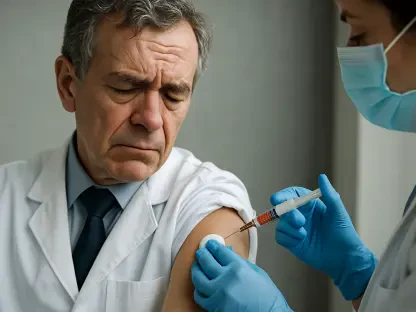In the aftermath of recent global health crises, the world has become acutely aware of the necessity for robust pandemic preparedness and biodefense strategies. The emergence of new infectious diseases and potential bioterrorism threats has underscored the importance of proactive measures at both national and international levels. Countries and organizations are now intensively focused on enhancing their capabilities to respond to future pandemic threats. This comprehensive overview examines the diverse approaches being adopted globally to mitigate these threats, including international treaties, legislative efforts, scientific advancements, and technological innovations. Each facet plays a critical role in shaping the global response to biosecurity challenges, highlighting the ongoing evolution of public health preparedness in a complex and interconnected world.
Global Collaboration and Pandemic Treaty Efforts
The formation of a global Pandemic Treaty marks a significant collaborative effort by WHO Member States to fortify international health security. This treaty emphasizes the importance of shared responsibilities and cooperative measures in dealing with pandemic threats. Its development aims to streamline processes for sharing scientific data and resources, ensuring a faster and more equitable response in the event of a global outbreak. Central to this effort is the establishment of a pathogen access and benefit-sharing system designed to promote equitable access to vaccines, therapeutics, and diagnostics. This system is pivotal in facilitating the distribution of medical countermeasures developed from shared datasets. The treaty reflects a shift towards global unity in addressing health threats, reinforcing the idea that pandemics require coordinated, collective actions beyond isolated national efforts.
Despite these global efforts, the exclusion of the U.S. from the negotiations has introduced challenges that could impact overall health diplomacy. As a major player in global health, the U.S. absence from treaty discussions raises questions about the alignment of international public health strategies and preparedness. Diplomatic dynamics and strategic interests have contributed to this exclusion, which may affect the treaty’s effectiveness in fostering a truly global response. The U.S. exclusion underscores the importance of inclusive dialogue and consensus-building among all nations to ensure robust and comprehensive pandemic preparedness. This situation not only affects the treaty’s framework but also sets a precedent for future international health collaborations.
Legislative and Policy Developments
Recent legislative efforts, such as the introduction of the Protecting American Families and Servicemembers from Anthrax Act, underscore the U.S. Congress’s commitment to modernizing biodefense strategies. This legislation highlights the need for updated approaches to maintaining effective anthrax stockpiles, a critical component of national biodefense given its potential use in bioterrorism. The act reflects a broader legislative focus on ensuring that biodefense frameworks remain agile and responsive to ever-changing geopolitical and technological landscapes. It demonstrates a commitment to safeguarding citizens through preemptive measures and improved readiness against biological threats, addressing vulnerabilities that could otherwise be exploited in the future.
Systematic approaches to combating bioterrorism threats have become increasingly essential in today’s dynamic geopolitical environment. As countries develop advanced deterrents, the nature and scope of bioterrorism evolve, requiring adaptive strategies that integrate innovations and anticipate emerging threats. These approaches involve comprehensive evaluations of current capabilities, investments in advanced research and development, and the cultivation of cross-sector partnerships to bolster national defenses. Additionally, legislative frameworks must evolve to facilitate rapid responses without compromising efficiency. Such proactive measures help protect populations and reaffirm government responsibilities in ensuring national security against biological aggression.
Scientific and Technological Advancements
The advent of new technologies, particularly artificial intelligence and DNA sequencing, has fundamentally transformed the landscape of biodefense and biosecurity. These innovations offer unprecedented opportunities to enhance preparedness, improve detection capabilities, and accelerate response operations. However, they also present significant challenges to traditional frameworks like the Biological Weapons Convention. The rapid pace of technological change often outstrips the ability of existing regulations to adapt, creating potential gaps in oversight and enforcement. These circumstances necessitate ongoing dialogues and innovative regulatory approaches to ensure that technological advancements contribute positively to protective efforts while minimizing risks of misuse or unethical applications.
With dual-use research increasingly prevalent, there is a growing consensus on the need for stronger international oversight mechanisms to prevent misuse of such technologies. Dual-use research, characterized by its applicability to both beneficial and harmful ends, poses unique ethical and security dilemmas. To address these concerns, international cooperation is essential in defining robust governance structures that balance innovation with safety. Creating frameworks for transparent communication and ethical standards ensures that research advances understanding and benefits humanity without endangering global security. Consequently, the international community faces the complex task of regulating dual-use research to protect the future while fostering scientific progress.
European Commission’s Updated Strategy
The European Commission’s efforts to refine its medical countermeasures strategy mark a critical step in aligning preparedness with current global health challenges. This updated strategy focuses on garnering comprehensive inputs related to vaccines, antimicrobials, and medical devices to address cross-border health threats effectively. By embracing a holistic approach, the Commission aims to fortify health security, ensuring that all elements of the healthcare infrastructure are prepared for potential crises. Through this initiative, there is a strong emphasis on fostering resilience in health systems across Europe, reflecting a strategic commitment to preemptive action and comprehensive crisis management in the face of future pandemics.
As the European Commission consolidates past efforts, its strategy endeavors to enhance policies that advance preparedness and response capabilities. By building on previous successes and lessons learned, the Commission seeks to establish a robust health security framework that not only responds effectively to immediate threats but also anticipates future challenges. This ongoing refinement involves continuous evaluation, adaptation, and integration of best practices drawn from member states and international partners. Such strategic consolidations are instrumental in maintaining a strong, unified front against health threats that transcend national borders, showcasing the paramount importance of cohesive, dynamic response systems.
Vaccine Trials and Medical Research
The ongoing Phase II trials led by the Sabin Vaccine Institute for a Marburg virus vaccine candidate illustrate the vital role of medical research in enhancing biodefense capabilities. Such trials are critical in advancing medical countermeasures against emerging pathogens, which pose significant threats to global health security. They represent a commitment to scientifically rigorous processes aimed at expanding the arsenal of effective vaccines available to combat deadly infectious diseases. The outcomes of these trials have the potential to significantly influence pandemic preparedness strategies and the overall efficacy of global vaccine distribution systems, underscoring research’s crucial role in addressing biological threats.
Exploration into filovirus infection countermeasures highlights significant advancements in tackling high-consequence pathogens. Ongoing investigations reveal not only incremental progress in vaccine development but also the refinement of therapeutic measures designed to support and enhance patient outcomes. These efforts draw on insights gained from past epidemic experiences, such as those encountered during the Ebola outbreaks, to shape contemporary approaches and improve countermeasure strategies. The integration of regulatory experiences from past epidemics is essential for advancing frameworks that govern medical innovations during health crises. Learnings from these situations enable a more responsive and adaptive approach to pandemic challenges, ensuring future countermeasures are robust and effective.
Biosecurity and Preparedness Challenges
The delay in the UK’s pathogen research hub serves as a stark reminder of the complexities involved in advancing national biosecurity strategies. Such setbacks highlight the importance of infrastructure investments and the continuous need for public and private partnerships to drive progress. These challenges underscore the necessity for governments to prioritize funding, resources, and policy support to overcome obstacles and build resilient research environments capable of addressing emerging biosecurity threats. By securing and advancing these capabilities, nations better position themselves to respond decisively and effectively to potential biological challenges on the horizon.
In addressing emergent diseases, global health systems face substantial challenges in adapting practices to mitigate outbreak risks. Rapid pathogen identification, enhanced surveillance capabilities, and agile response systems are imperative for minimizing impacts and saving lives. This adaptive approach requires comprehensive strategies that leverage technological advancements and integrate cross-disciplinary efforts to improve overall readiness. By fostering an environment that encourages innovation and agility in health system responses, countries can more effectively tackle unforeseen challenges posed by emergent diseases. The ability to successfully navigate these complex scenarios is a testament to the resilience and adaptability of global health systems.
The development of agile public health emergency systems is critical for ensuring rapid and effective responses during bioterrorism events. Such systems must be capable of swiftly implementing containment measures, mobilizing resources, and orchestrating coordinated responses across jurisdictions. To achieve this, investments in training, infrastructure, and technology are essential, enabling public health professionals to act decisively during crisis situations. The necessity for these systems becomes evident as they form the backbone of prompt, decisive actions that mitigate the impacts of bioterrorism. A robust emergency response infrastructure ensures that communities remain protected amid uncertain threats, reinforcing public confidence in health security measures.
Infectious Disease Surveillance and Response
Ongoing surveillance and response strategies concerning current Lassa fever outbreaks in Nigeria reflect the challenges and successes in infectious disease control. Effective monitoring, rapid response measures, and public health education programs are vital components in managing these outbreaks and limiting their spread. Nigeria’s relentless efforts in this area showcase the importance of robust surveillance systems and cross-border information sharing in mitigating infectious disease threats. These strategies provide invaluable lessons for other regions facing similar challenges, emphasizing the necessity for sustainable, integrated responses to ensure long-term health security and resilience against persistent disease threats.
In parallel, the recent outbreaks of measles and whooping cough in the U.S. highlight the challenges public health authorities face in preventing the resurgence of previously controlled diseases. Vaccination campaigns, public education, and improved healthcare access are essential for containing these outbreaks and safeguarding population health. The persistence of these diseases underscores the importance of maintaining high vaccination rates and robust surveillance systems to promptly detect and address potential outbreaks. Continual improvement and adaptation of these strategies are critical in ensuring the effectiveness of public health interventions and the protection of vulnerable populations from preventable diseases.
Continuous assessment and improvement of infectious disease response capabilities remain a cornerstone of effective surveillance. As pathogens evolve and new threats emerge, enhancing these capabilities becomes a perpetual priority for public health systems worldwide. Regular evaluations, technological integrations, and data-driven insights are crucial for refining response strategies and maintaining a state of readiness. Emphasizing agility and adaptability, public health professionals can better anticipate and manage infectious disease threats, ensuring prompt and efficient interventions that protect communities and save lives.
Comprehensive Approach to Health Security
The establishment of a global Pandemic Treaty signifies a substantial joint effort among WHO Member States to bolster global health security. This treaty underscores the necessity of shared responsibilities and collaborative strategies in tackling pandemic threats. Its goal is to expedite the sharing of scientific information and resources, guaranteeing a more rapid and equitable response when a global outbreak occurs. A cornerstone of this initiative is the development of a pathogen access and benefit-sharing framework, intended to ensure fair access to vaccines, treatments, and diagnostics, thus facilitating the distribution of essential medical countermeasures derived from shared data. This treaty marks a notable shift toward global solidarity in tackling health challenges, emphasizing that pandemics demand coordinated actions beyond individual national endeavors.
Nonetheless, the absence of the U.S. from negotiations poses challenges impacting health diplomacy. As a pivotal entity in global health, the U.S. exclusion from treaty discussions sparks questions concerning the alignment of international public health strategies. Diplomatic dynamics and strategic interests led to this exclusion, potentially hindering the treaty’s ability to foster a truly global response. This highlights the need for inclusive dialogue and consensus-building among all nations to ensure comprehensive pandemic preparedness, affecting the treaty’s framework and setting a precedent for future international health collaborations.









